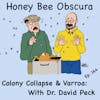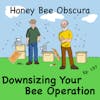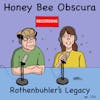Building Your Own Bee Equipment (103)

What beekeeper hasn't nailed together a hive body and thought, "Heck, I can cut these boards myself and it'd be cheaper!" Especially if they already have a wood shop with a table saw and a few other tools. But is it really? What are the pros and cons...
What beekeeper hasn't nailed together a hive body and thought, "Heck, I can cut these boards myself and it'd be cheaper!" Especially if they already have a wood shop with a table saw and a few other tools.
But is it really? What are the pros and cons of building your own equipment? Why should you even try?
On today's episode, Jim Tew invites Jeff Ott from Beekeeping Today podcast to the show to talk about building your own beekeeping equipment. They both have done it. Are they doing it still?
We hope you enjoyed today's episode. Please follow or subscribe today and leave a comment. We'd love to hear from you!
___________________
Thanks to Betterbee for sponsoring today's episode. Betterbee’s mission is to support every beekeeper with excellent customer service, continued education and quality equipment. From their colorful and informative catalog to their support of beekeeper educational activities, including this podcast series, Betterbee truly is Beekeepers Serving Beekeepers. See for yourself at www.betterbee.com
______________________
Honey Bee Obscura is brought to you by Growing Planet Media, LLC, the home of Beekeeping Today Podcast.
Music: Heart & Soul by Gyom, All We Know by Midway Music, original guitar music by Jeffrey Ott
Copyright © 2022 by Growing Planet Media, LLC

Episode 103 – Managing Winter Colony Die-Offs
[music]
Jim Tew: Years ago, when I was an energetic beekeeper, I actually built my own equipment. In fact, that's one of the reasons I got started in beekeeping. Kim is not here today. I've asked Jeff to set by. Jeff, you okay talking about this?
Jeff Ott: Sure, Jim. Thanks for inviting me to Honey Bee Obscura. I'd be happy to talk about woodworking and beekeeping equipment. I used to do some of that.
Jim: Didn't we all? I'm glad you're here. Thanks for setting in. Hi, I'm Jim Tew.
Jeff: I'm Jeff Ott, from Beekeeping Today Podcast.
Jim: We're coming to you on Honey Bee Obscura, where once a week, we talk about something to do with beekeeping. Today, one of us, either I or Jeff, decided to talk about how we, in our lives, combine two hobbies-- Woodworking and beekeeping.
Introduction: You are listening to Honey Bee Obscura, brought to you by Growing Planet Media, the folks behind Beekeeping Today Podcast. Each week, on Honey Bee Obscura, hosts Kim Flottum and Jim Tew explore the complexities, the beauty, the fun, and the challenges of managing honey bees in today's world. Get ready for an engaging discussion to delight and inform all beekeepers. If you're a long-timer, or just starting out, sit back and enjoy the next several minutes as Kim and Jim explore all things honey bees.
Jim: Doesn't take it long to get it out of your system in most cases, does it, Jeff?
Jeff: No. About the first weekend. [laughs]
Jim: I have been a woodworker all my life. I'm not accomplished. I would say that I'm a click to a click and a half above average. I've got five reasonably nicely set up woodworking shop, that I don't use often enough. As a young man, when I stumbled into beekeeping, literally, almost taking a beekeeping class by accident, when I saw all that wooden stuff, I had the thought that has lived with me forever-- I can build all of this. Yes, right. What beekeeper, with any woodworking tools at home, hasn't thought that?
Jeff: I was going to say that's a very common thought for many beekeepers, say, "Well, that's a simple box. I can do that and I can save lots of money," or, "I can do that." That's just basically it. I can do that.
Jim: Well, I was naive at first. I was going to do it because I could do it and the equipment would be almost free, just the cost of the lumber, nevermind the cost of all the tools, the time, that didn't matter, if it's going to be almost free. I got, and I get, a significant feeling of satisfaction. This is really my bee operation. I built the boxes, I raised the queens. I'm with this thing from the ground up. It gives me a great sense of satisfaction.
In fact, Jeff, everything I've ever built, any furniture, anything, I could have bought cheaper. It didn't take me long to realize that you're never going to be able to build this stuff cheaper than the big supply companies.
Jeff: Well, they have the power of buying in bulk. Look at price of lumber these days, it's just through the roof. I guess, wait, we're starting out the very beginning of this episode, just talking, you're not going to save money building your own bee equipment, but that's not the reason why you do it.
Jim: No. It was, at first. It was, briefly. Ever so briefly. What really broke me, Jeff, was-- On Christmas morning, just as quickly as I could get through the ceremony of gift-giving and pondering the significance of the event. Just the time I could get away, I dashed out the dad's shop and began to knock out blanks that I was going to use to build my own end bars with. For about a year, I built my own frames. One time, I counted. It must have had 17, 15, 14, 15 different cuts and different setups, to build each of those frames.
I realized, with the stack of those things there, like an epiphany-- What are you doing? It's Christmas day and you're out here cutting out blanks to build in bars that will cost you three times more than what the end bars I could buy would cost. I begin to get my feet back on the ground and to realize that you need to woodwork just as much as you need to, but I'm probably not going to build my own equipment. Why would I say that?
I'm firing off somebody out there, who's got a shop set up, dedicated stationary saws, jigs that work everything, and they knock out this stuff by the thousands. I'm not talking about those people. I'm talking about Billy Joe beekeeper with the table saw, that's the guy I'm looking at.
Jeff: I think it's a worthwhile effort. I think if you're a beekeeper, you have a skill set with woodworking, and you have the tools, why not? I think you should do yourself a favor and build a box, build a top, build a bottom board.
Jim: Absolutely. Stop building a birdhouse. You can buy birdhouses all day cheaper than you can just lock a birdhouse together, but you build your own birdhouse and the birds move in, you just feel so nurturing about the whole thing. I use number two pine lumber, but I've also used scrap. At Ohio State, I came across a large pile of scrap plywood that was given to the bee program. I worked mightily to get a square edge on one side, and then cut blanks out of that. I must have made 80 or 90 migratory tops out of it.
The second thing, Jeff, is-- Where do you get your lumber? If you're having to go over to Big-box store and buy three boards at the time, that's really going to set you back. If you're going to go buy a pickup truckload, then you're getting in deeper and deeper, aren't you? Where you get your lumber, how you come about it, it's the whole thing.
Jeff: Some of the beekeepers I know, who build their own equipment-- They don't build it all the time. The guys I know-- Is scrap lumber. They'll pick up odds and ends, and like you said, with Ohio State, you cut a square edge and then build everything from that. It might be you have multiple different types or origin sources of your lumber and they just enjoy the scrappiness of building their own equipment.
Jim: Yes. I wasn't going there. I hadn't thought about that, but you're right. Not only was I building my own equipment for a project that I love, beekeeping, I was also repurposing this old plywood lumber that came from the dairy farm. It had an ambiance about it. When you heated that wood up and cut it, boy, you were back in the dairy business all of a sudden. Then those migratory covers, those are just flat board covers.
They could not be any simpler. They're just a flat board cover with a cleat on both ends. Commercial beekeepers use migratory covers a lot.
Jeff: Since we're talking about lumber source, and lumber, is there any lumber that a beekeeper wanting to make their equipment should steer away from?
Jim: Should steer away from, or if you use it, you should know the characteristics of it. Now I'm caught off guard. Great question, that I haven't had much response time to. If you use aromatic red cedar, it's been said that the bees are not crazy about that, no more than clothes moths are crazy about aromatic red cedar. Here in Ohio, Amish men sometimes use red cedar, with the strong cedar odor, to build an inter cover. They have some notion that, in some way, that helps do something with wax moths, I'm not sure what.
The first species of lumber that comes to mind is aromatic red cedar, due to the insect repelling characteristics of it. Others have said that black walnut. Why in the world would you use black walnut to build a bee box, I don't know, but black walnut, with its juglans compound in it, suppresses growth beneath the tree. That can be iffy stuff. I understand people don't use black walnut for horse bedding. Can you address that?
Jeff: Jim, no, we never used black walnut for horse bedding. It's a known problem for horses, a condition called Laminitis. It was never offered to us, we wouldn't have taken it if it was given to us, and quite honestly, I don't know whether it's a problem for beekeepers and bees. Maybe one of our listeners knows.
Jim: I got an Amish beekeeping friend who preferentially builds all-- He builds it for sale. I mean every year to go down to the neighboring county and buy some. He makes it out of sassafras. I don't know why, but anytime I work sassafras, and I've worked it a lot, it always smells like shrimp boil to me. I always think about boiled or steamed shrimp when I'm working sassafras, and the stuff undergoes a radical color change. I was at an Amish bee meeting, last July.
He was there, with his sassafras bee equipment, and I asked him, "What's up with that? He said, "I just really like sassafras." He has to glue the boards up to get them wide enough. I need to buy some before this guy stops doing it.
Jeff: That would be interesting. We used to pull twigs of sassafras and chew on them. and I enjoyed this taste, but I never considered making any bee equipment out of it.
Jim: I can tell you for a fact, there's people who are eager to sell you that if you don't want it. We've got one of those companies right here, who sponsor us.
Betterbee: Hi. We're starting the winter holiday celebrations. Nothing is better for a stocking stuffer, hostess' gift, or party favor, than honey, homemade hand cream, candles, or lip balm. If you want to learn how to craft these or other products of the hives, such as beeswax, you can visit betterbee.com for tips, tricks, and products made by love, by you, and your honey bees. From all of us at Better Bee, we wish you wonderful winter holidays and terrific celebrations.
Jim: For those of you who are just listening to us and thinking, "Oh, that's probably like a bird box. I should probably build a bee box." Don't even worry about the joints. Just use the simple butt joint. Just nail them together and then just know that you're never going to move that bee box to Florida. It would not stand the stress and the weight, but if you want to build the simplest box you can, just use butt joints. Just put two boards together and nail them up.
Jeff: I glue them. I would recommend you get some old, good all-purpose glue, all-weather glue, and make sure you glue that joint well.
Jim: Certainly wouldn't hurt. Use spiral shank nails, right away, we're taking a simple box and making it complicated, but most of us, what I did most of, was rabbet joints. Just those simple rabbet joints that I cut on a table saw. I would almost say, Jeff, that a table saw is a necessity. You can get by with a router if you're building a few, but if you're really going to knock out some bee boxes, you're going to need a table saw.
Jeff: You were talking about the joints, and a simple box joint. I remember the one summer I built equipment. I had my fancy dancy, big craftsman router, and I got a dove joint. router jig. [laughs]
Jim: [crosstalk] I knew you were going to say that.
Jeff: Sometimes I wonder if someone's still sitting around with that box in their backyard. I'm sure it's not there now, but sitting there, "Who's the fool who spent the time making dove joints?"
Jim: Making true dovetails?
Jeff: Yes. That's funny.
Jim: A lot of beekeepers call those box joints finger joints. From a woodworking standpoint, they're not the same thing. A box joint is what is commonly used to manufacture bee boxes. I can't think of the name of it, Jeff, but there was a company that, probably in the early '80s, just went away, like these providers so often do, but they made a dedicated, small table saw for cutting box joints. You had to provide your own motor. They sent you the simple table saw.
There was no height adjustment, everything was preset. You put their jig on there and you began to knock out box joints immediately. Interestingly-- We'll talk more about this in a bit, maybe. Maybe not. They put in a wing cutter. A what? A wing cutter, W-I-N-G. It was a dangerous-looking thing. Big piece of equipment that you put on the side of the dado head and it would cut out the handhold, but you needed a three-quarter to a one-horse motor because it would really pull that motor down.
Little bit of smoke, some chip out, but it gave you something that was a pretty good rendition of a handhold. I'm into this now because that company that sold that equipment is all gone. I don't know if you can even find the stuff used.
Jeff: That's an interesting consideration because you don't really need to cut in handholds. You can take someone by and build just grips on the side of the box. Many beekeepers do that and they work effectively.
Jim: Someone doesn't have to take the time to write us and say, "Well, you can't stack that equipment side by side." You're going to have an inch and a half space between every stack of equipment because the handhold's butt up, but they are so easy to do. I want that same bottle of glue that you had a bit ago. Take that one-and-a-quarter to one-and-a-half inch strip, three-quarter inches thick, 16 and a quarter inches wide.
Put in three screws, glue that on and it makes an improved handhold, that I know beekeepers, whose name I shouldn't call, would put those strips on over the manufactured handholds, because they locked them so much better.
Jeff: If you use telescoping tops, then having that strip on the side is not going to make any difference anyways. You're not going to be stacking them side by side, bunched up against each other.
Jim: Now you're getting defensive.
Jeff: No, I'm not defensive. I'm not defensive. [laughs]
Jim: [laughs] Now you're whining. About a fourth of my boxes have the cleats on there. I got them somewhere else. I put them on for demonstrative purposes, but the cleats are there. Most of us just use our dado head, slice into the face of the board, and cut a slot there, which is always a sign that it's homemade equipment. That's always a characteristic of homemade equipment. It's too hard to make an authentic-looking handhold.
Jeff: One of the things that always comes to my mind these days is insulation. When we're talking about handholds-- I do recall that one of the considerations about handholds is you're taking away material on the side of that hive, that's going to create a colder spot. Now, whether that really, in the big picture of things, really makes a difference inside the hive and the thermal dynamics, et cetera, so forth, I don't know, and I don't know if there's any studies.
Then I start thinking, besides the handholds issue, what about the dimensions of the lumber? If you're building your own equipment, you're not stuck to the lumber that you can find at your local big box store. You can get thicker lumber, maybe to buy, and more insulation value. Of course you have to carry it more. What's your thoughts on that? Making standard-size equipment out of non-standard lumber?
Jim: My first thought is an odd one, is one of fright. If I start changing the thickness of the lumber, then I'm going to change other dimensions too. I'm going to need to be very careful that everything else still fits, especially the inside dimensions. I said one thing today, that's critical. If you're going to build from anything, any thickness lumber, you've got to have those inside dimensions spot on, those frames fit. The box has got to be square. Inside dimensions have got to be spot on and the box has got to be square.
Everything else is up for grabs. What's my opinion? If I had one-inch stock, I'd probably build it and take too much time to plan it down, but as far as insulation parameters, I'd probably just isolate it with some of the modern-day bags, sacks, wraps, whatever.
Jeff: All right. Fair enough.
Jim: I support the insulation thing. Kim and I have talked about that in other episodes, and that's an interestingly complex subject. Maybe more on that later, I guess.
Jeff: You mentioned dimensions and maintaining interior spacing, you should maintain bee space. If not, then you're going to have to deal with the consequences. It makes me think of when I did the article for Kim, eons ago, on wooden wear for bee culture. I noted all the differences where different manufacturers maintain their bee space between supers. Was that space on top of the frame, bottom of the frame, or was it split the difference between the top the frame and the bottom of the frame, above it?
If you didn't maintain that bee space between supers, then you had a preponderance of burr comb or the frame stuck together, both of which made the beekeeper's life much more difficult.
Jim: That that is a superb point. It's a dirty secret that we say we have standardized beekeeping equipment. We have equipment that's 96% standardized, and that lasts 4%-- I'm making those percentages, up by the way, but that last 4% can just drive you crazy, because you're exactly right. Is there a quarter wrench on the bottom, and the rest of the bee space up top, or is all the bee space up top and flush on the bottom?
I guess, having not thought about it, and saying this spontaneously-- If you're going to build your own box, pick out a box that you really like, that you've been using already, and your equipment has worked and built, use that as a pattern. If you go to the web and pull one off, how deep is your rabbet going to be? Some rabbets for frame rest are going to be five eights. If you have a frame lifter, you'd want to cut that rabbet at seven eights. There's all these little variations, just enough, in the details, to drive you crazy.
The one you bring up is certainly a good one. They will glue that thing, that super down, solid, after a good nectar flow. You're going to have to have a wrecking bar to get that super separated, with all that comb attaching it.
Jeff: I can say this from experience, you really want to pay attention to that bee space between supers. It's a self-correcting mistake. I'll just say that.
Jim: I want to be crystal clear. We're winding down. I always built bee equipment just because I enjoyed--
Jeff: Yes.
Jim: I was satisfied, I was fulfilled. I realized quickly, I'm probably never going to save any money, but I was at home, I was happy, I slept well at night, I smelled like pine shavings most of the day. It was a good way to go. I had a good time doing it. For those of you who still enjoy it, nothing wrong with it, have at it. For those of you who want to buy your boxes and never build one, boy, that's another way to go. That's fine too.
Jeff: There's a lot of resources for people who have the desire to learn and build their own. There's Facebook groups, there's books, there's websites. You won't be making things up on your own. There's a lot of resources for you.
Jim: You will not. It's like you're a specialized beekeeper, not just queen production, and not just pollen collection, but you're a woodworking beekeeper.
Jeff: It keeps you out of trouble in the wintertime.
Jim: Yes. I've always enjoyed it. I'm going to keep my tools as long as I am, but I probably won't build bee boxes anymore.
Jeff: Well, I appreciate you giving me the opportunity to come on the show today and talk about building your own bee equipment. I don't think I'm going to run out and buy any more equipment today, but it was an enjoyable experience when I did it, and I'm happy I did it.
Jim: I enjoyed talking to another woodworker for a change, instead of another beekeeper. All right. I wish you all the best.
Jeff: Thanks lot, Jim. Thanks.
Jim: All right. Until next time. Bye-bye.
[00:22:56] [END OF AUDIO]
New to Honey Bee Obscura Podcast?
Here are some great episodes to start with. Or, check out episodes by topic.







 What beekeeper hasn't nailed together a hive body and thought, "Heck, I can cut these boards myself and it'd be cheaper!" Especially if they already have a wood shop with a table saw and a few other tools.
What beekeeper hasn't nailed together a hive body and thought, "Heck, I can cut these boards myself and it'd be cheaper!" Especially if they already have a wood shop with a table saw and a few other tools.






